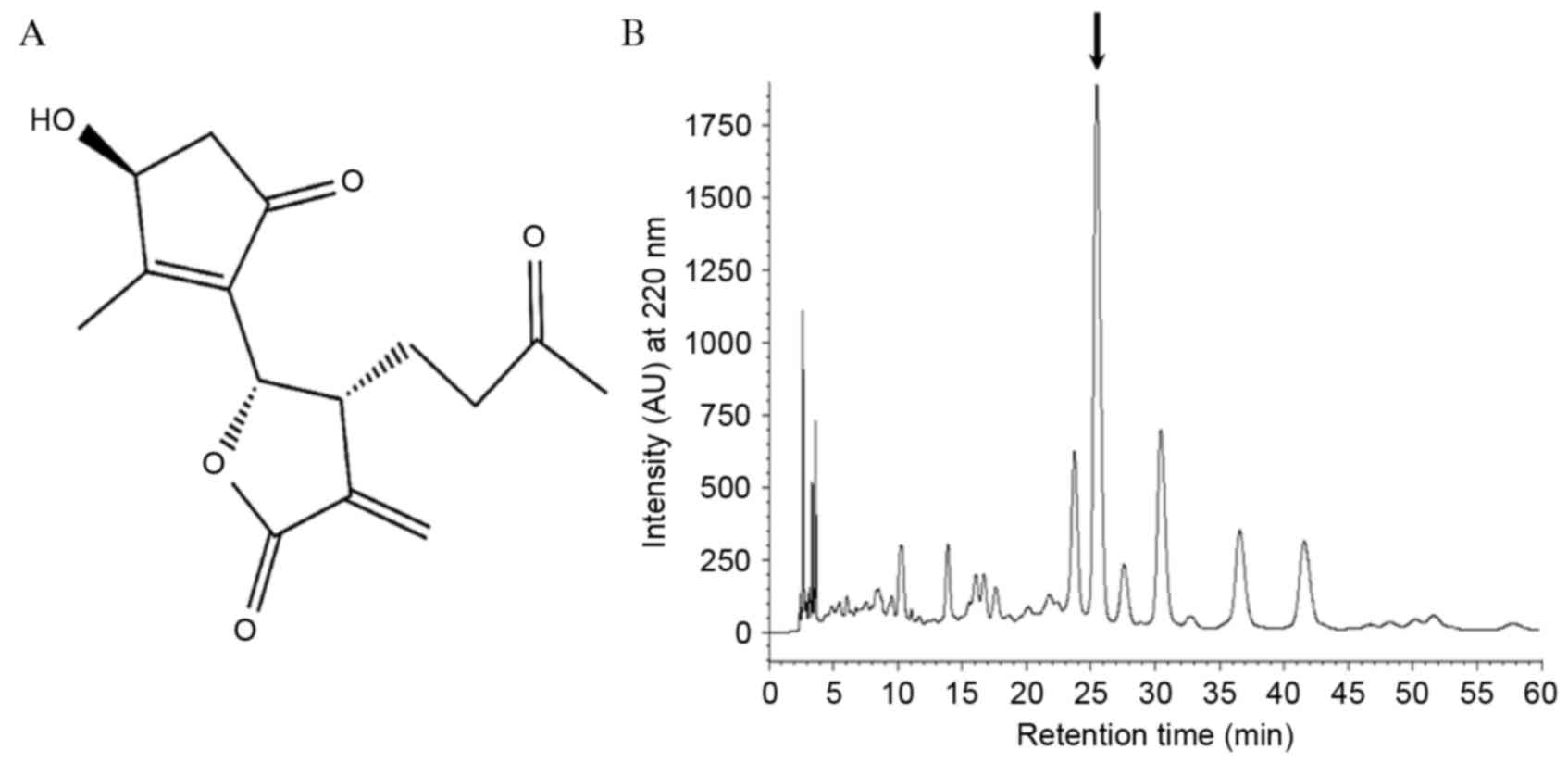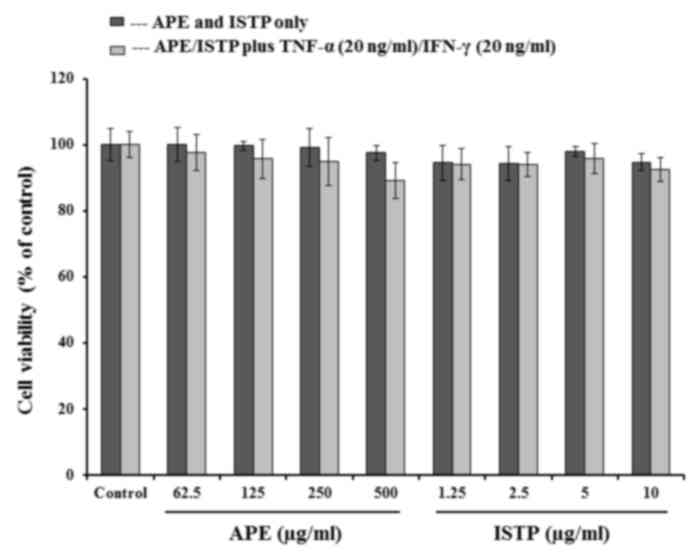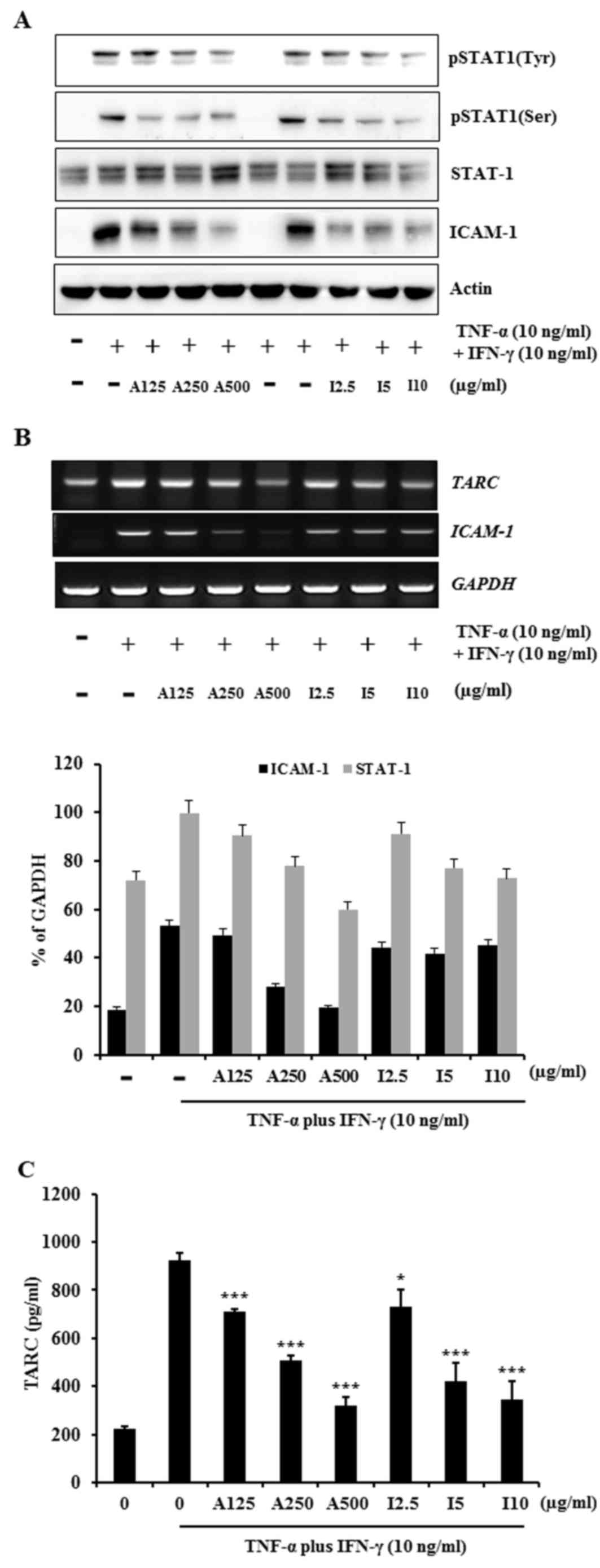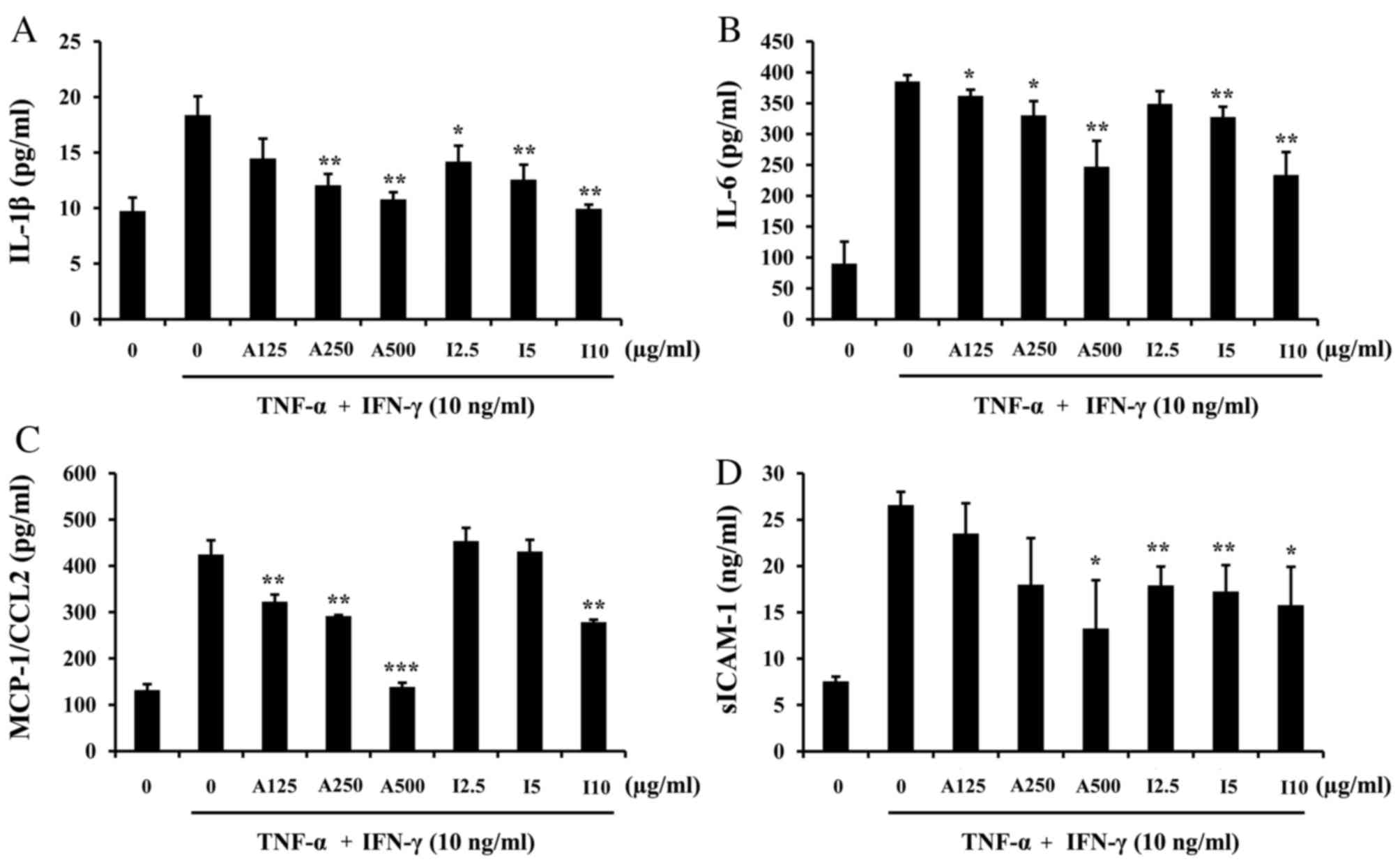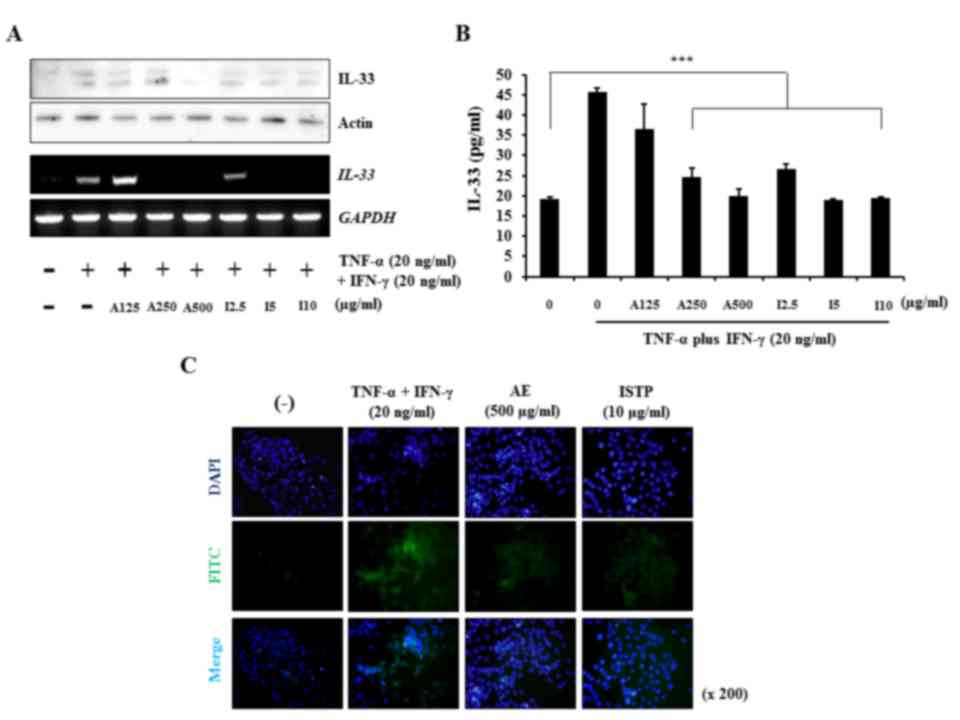Effect of isosecotanapartholide isolated from Artemisia princeps Pampanini on IL‑33 production and STAT‑1 activation in HaCaT keratinocytes
- Authors:
- Published online on: March 9, 2017 https://doi.org/10.3892/mmr.2017.6306
- Pages: 2681-2688
Abstract
Introduction
Cytokines and chemokines are involved in the development of numerous inflammatory skin disorders (1). Abnormal and dysregulated expression of inflammatory mediators in keratinocytes is associated with the pathogenesis of chronic inflammatory skin diseases (2). Upon stimulation by inflammatory cytokines, including tumor necrosis factor-α (TNF-α) and interferon-γ (IFN-γ), epidermal keratinocytes express adhesion molecules such as intracellular adhesion molecule 1 (ICAM-1) (3). A previous study indicated that the serum levels of ICAM-1 are associated with the disease progression of atopic dermatitis (AD) (4). Modulation of ICAM-1 expression in epidermal keratinocytes therefore provides a strategy for the development of therapeutic agents for the treatment of various inflammatory skin diseases (5). In addition, exposure of keratinocytes to TNF-α and IFN-γ leads to dysregulated expression of cytokines and chemokines, and increased infiltration of monocytes/T cells into the site of inflammation (6). Thymus and activation-regulated chemokine (TARC/CCL17) is constitutively expressed in the thymus and is produced by dendritic cells, endothelial cells, keratinocytes and fibroblasts (7). Furthermore, keratinocytes increase TARC production in the lesional skin of AD (8). Therefore, modulation of keratinocyte TARC production may contribute to the pathological processes of inflammatory skin diseases including AD.
Artemisia princeps Pampanini (AP) is a herbaceous plant that is widely used in traditional medicine in Asia (9). Various species of Artemisia have been demonstrated to exhibit functional properties, including immunostimulatory (10), anticancerous (11), anti-inflammatory (12) and antibacterial (13) effects. The constituents of AP have been reported by Ryu et al (14), and include the flavonoids eupatilin and jaceosidin. Isosecotanapartholide (ISTP), a sesquiterpene lactone isolated from Artemisia rutifolia and Artermisia iwayomogi, has anti-inflammatory and anticancer properties (15). In addition, it inhibits nitric oxide synthase (16). However, there is limited clinical evidence to support the anti-inflammatory effects of ISTP. Therefore, the present study investigated the anti-inflammatory effects of ISTP isolated from ethanol extracts of AP.
Interleukin-33 (IL-33) is associated with type 2 immune responses (17) and is important in the pathogenesis of various type 2 helper cell (Th2)-associated inflammatory conditions and allergic reactions (18). Natural helper cells and nuocytes produce abundant Th2 cytokines following stimulation by IL-33 (19). The mature form of IL-33 is released into the cytoplasm and stimulates keratinocytes, T cells and mast cells. Subsequently, IL-33 may act as a transcription factor by trafficking into the nucleus, where it regulates various inflammatory responses (20). The present study investigated the effect of ISTP on the production of TARC and IL-33 in TNF-α- and IFN-γ-stimulated HaCaT keratinocytes. In addition, the mechanism of action of ISTP was examined.
Materials and methods
Extraction and isolation of active components
AP was purchased from a herb shop at Gyeongdong medicinal herb market (Seoul, Korea). High-performance liquid chromatography (HPLC)-grade methanol, and ethanol, ethyl acetate and dichloromethane were purchased from Duksan Pure Chemicals Co., Ltd. (Ansan, Korea). Dimethyl sulfoxide-d6 (DMSO-d6), a common solvent used in nuclear magnetic resonance (NMR) spectroscopy, was purchased from Sigma-Aldrich; Merck Millipore (Darmstadt, Germany).
Dried AP (5 kg) was extracted with ethanol (95%) for 3 or 4 days at room temperature. Following filtration through a 400-mesh filter, the product was passed through filter paper (Whatman® Grade 5) and concentrated under reduced pressure by rotary evaporation (EYELA N-1000; Tokyo Rikakikai Co., Ltd., Tokyo, Japan). The ethanol extract of AP (279.4 g) was suspended in H2O and extracted with ethyl acetate to obtain an ethyl acetate soluble layer (97.8 g). The ethyl acetate soluble layer (97.8 g) was mixed to a silica column (97.8 g) and concentrated, followed by oven drying to obtain a coating loading powder. Then 20 g of powder was loaded into a silica open column (4.5×40 cm) filled with 100 g silica. The solvent was developed by gradient elution with methanol in dichloromethane (80:1, 50:1, 30:1, 20:1, 15:1, 5:1, 1:1). Sub-fractions (n=6; APEA-1 to APEA-6) were collected, and the concentrate (22.5 g) of APEA-3 containing the active ingredient was dissolved in 20 ml of 30% (v/v) methanol and filtered through a 0.45 µm filter. Then, in order to purify the active ingredient, a Shim-Pack Prep-ODS column (20×250 mm; 5 µm), packed with silica gel at a flow rate of 10 ml/min and an injection volume of 50 µl was dissolved in a methanol-H2O solution (50:50). Following purification using a Prep LC column (Shimadzu Co., Kyoto Japan) and vacuum drying, pure ISTP was obtained (111 mg). This active component was identified by 1H-NMR and 13C-NMR (16,21). Nuclear magnetic resonance (NMR) spectroscopy was used to analyze the structure of the compounds separated by H1-NMR for Varian (GEMINI, 400 MHz) and C13-NMR for Varian (GEMINI, 100 MHz). DMSO (Sigma Aldrich) was used as a solvent and the NMR results were consistent with the previous studies (data not shown). ISTP: syrup, 1H-NMR (DMSO-d6, 400 MHz): δ1.70 (1H, m, H-8), 1.85 (1H, m, H-8′), 2.05 (3H, s, H-14), 2.08 (1H, d, H-2), 2.11 (3H, s, H-15), 2.45 (2H, m, H-9), 2.66 (1H, dd, J=18.2, 6.2 Hz, H-2′), 3.05 (1H, m, H-7), 4.55 (1H, s, H-6), 5.02 (1H, d, J=5.6 Hz, H-3), 5.61 (1H, brs, -OH), 5.73 (1H, d, J=2.5 Hz, H-13), 6.11 (1H, d, J=2.9 Hz, H-13′), 13C-NMR (DMSO-d6, 100 MHz): δ13.4 (C-15), 26.8 (C-8), 29.7(C-14), 39.1(C-9), 41.3(C-7), 44.3(C-2), 69.7(C-3), 75.4(C-6), 121.6(C-13), 135.7(C-5), 139.1(C-11), 169.6(C-12), 175.0(C-4), 203.4(C-1), 207.6(C-10).
HPLC analysis
A modular Shimadzu LC-20A System was utilized. A Capcell Pak C-18 Column (250×4.6 mm internal diameter×5 µm; Shiseido Co., Ltd., Tokyo, Japan) was used at 30°C. Isocratic elution [mobile phase, solvent mixture of methanol (15%)] was performed for 1 h at a flow rate of 1 ml min−1 with an injection volume of 20 µl. The UV detector was set at a wavelength of 220 nm.
Human keratinocyte cultures
HaCaT cells (immortalized human keratinocyte cell line, obtained from American Type Culture Collection, Manassas, VA, USA) were cultured in Dulbecco's modified Eagle's medium (DMEM; Welgene Biotech, Taipei, Taiwan) supplemented with 10% fetal bovine serum (Thermo Fisher Scientific, Inc., Waltham, MA, USA) and 100 U/ml penicillin/streptomycin at 37°C and 5% CO2. Cells (5×105 cells/dish in 60 mm dishes) were pretreated with 10 ng/ml TNF-α and 10 ng/ml IFN-γ at 37°C and 5% CO2 for 30 min and subsequently incubated with 2.5, 5 or 10 µg/ml ISTP or 125, 250 or 500 µg/ml AP extract (APE) for 30 min at 37°C and 5% CO2. For induction of IL-33, HaCaT cells were treated with 20 ng/ml TNF-α and 20 ng/ml IFN-γ at 37°C and 5% CO2 for 30 min (22).
Cell Counting kit-8 (CCK-8) assay
HaCaT cells (2.5×104 cells/well) were seeded into 96-well plates and their proliferation was measured using a CCK-8 assay (Dojindo Molecular Technologies, Inc., Rockville, MD, USA). Cells were treated with 62.5, 125, 250 and 500 µg/ml APE or 1.25, 2.5, 5 and 10 µg/ml ISTP for 24 h. Cells were subsequently incubated with TNF-α (20 ng/ml) and IFN-γ (20 ng/ml) for 30 min at 37°C and 5% CO2. CCK-8 solution (10 µl) was added to the cells in 1 ml DMEM and incubated for 2 h at 37°C. Absorbance was measured at a wavelength of 450 nm using a microplate reader (SpectraMax 340; Molecular Devices, LLC, Sunnyvale, CA, USA).
Western blot analysis
Western blot analysis was performed as described previously (23). Proteins were quantified using a Bio-Rad DC Protein assay kit II (Bio-Rad Laboratories, Inc., Hercules, CA, USA). Equal amounts of protein were separated by SDS-PAGE, transferred to polyvinylidene difluoride membranes and incubated with the following primary antibodies: Rabbit anti-phosphorylated (p)-STAT-1 phosphorylated at tyrosine 701 (pY-STAT-1; 1:1,000; cat. no. 9167; Cell Signaling Technology, Inc., Danvers, MA, USA); rabbit anti-p-STAT-1 phosphorylated at serine 727 (pS-STAT-1; 1:1,000; cat. no. 9177; Cell Signaling Technology, Inc.); rabbit anti-total STAT-1 (1:1,000; cat. no. 9172; Cell Signaling Technology, Inc.); mouse anti-ICAM-1 (1:1,000; cat. no. ab2213; Abcam, Cambridge, MA, USA); rabbit anti-β-actin (1:1,000; cat. no. 4967; Cell Signaling Technology); and anti-IL-33 (1:1,000; cat. no. sc-98659; Santa Cruz Biotechnology, Inc., Dallas, TX, USA).
Measurement of chemokines
The concentration of six cytokines and chemokines [IL-1β, IL-6, monocyte chemoattractant protein-1 (MCP-1)/CCL2, TARC, soluble ICAM-1 (sICAM-1) and IL-33] were measured in cell supernatants using human ELISA kits as follows: Human IL-1β (ELISA ready-SET-GO; cat. no. 88-7261, eBioscience, Inc., San Diego, CA, USA), human CCL2 (MCP-1) (ELISA ready-SET-GO; cat. no. 88-7399, eBioscience, Inc.), human sICAM-1 (Platinum ELISA; cat. no. BMS201CE; eBioscience, Inc.), human IL-33 (Platinum ELISA; cat. no. BMS2048, eBioscience, Inc.), and human CCL17/TARC (Quantikine ELISA kit; cat. no. DDN00, R&D Systems, Inc., Minneapolis, MN, USA). ELISA was performed according to the manufacturer's protocol.
RNA extraction and gene expression
RNA was isolated from HaCaT cells using an RNeasy Plus Mini kit (Qiagen, Inc., Valencia, CA, USA) according to the manufacturer's protocol. Reverse transcription was performed using the RevertAid First Strand cDNA synthesis kit (cat. no. #K1622; Thermo Fisher Scientific, Inc.). Quantitative polymerase chain reaction (qPCR) was performed using the EmeraldAmp GT PCR Master Mix (cat. no. RR310A; Takara Biotechnology Co., Ltd., Dalian, China). The primers for the qPCR were as follows: Human GAPDH, 5′ AGG GCT GCT TTT AAC TCT GGT 3′ (sense) and 5′ CCC CAC TTG ATT TTG GAG GGA 3′ (antisense); ICAM-1, 5′ CAC CCT AGA GCC AAG GTG AC 3′ (sense) and 5′ CAT TGG AGT CTG CTG GGA AT 3′ (antisense); TARC, 5′ CTT CTC TGC AGC ACA TCC 3′ (sense) and 5′ AAG ACC TCT CAA GGC TTTG 3′ (antisense); IL-33, 5′ AGC CTT GTG TTT CAA GCT GG 3′ (sense) and 5′ ATG GAG CTC CAC AGA GTG TTC 3′ (antisense). The thermocycling conditions were as follows: An initial denaturation step at 94°C for 2–10 min, followed by 30–35 cycles of denaturation at 94°C for 30 sec to 3 min, annealing at 50–58°C for 30 sec to 1 min and extension at 72°C for 30 sec to 1 min, and a final extension step at 72°C for 4–7 min. The digitized gel images were analyzed using Quantity One 1-D Analysis software version 4.6.5 (Bio-Rad Laboratories, Inc.).
Immunocytochemistry
HaCaT cells (1.5×104 cells/well) were seeded onto a 4-well chamber slide and treated with TNF-α (20 ng/ml), IFN-γ (20 ng/ml), ISTP (10 µg/ml) or APE (500 µg/ml) for 24 h at 37°C incubation. Following fixation in 100% methanol (chilled at −20°C) at room temperature for 5 min and permeabilization, cells were incubated with 1% BSA/ 22.52 mg/ml glycine in PBS/0.1% Tween-20 (PBST) for 30 min to block unspecific binding of the antibodies. Then, cells were incubated overnight at 4°C with an anti-IL-33 primary antibody (1:100; cat. no. sc-98659, Santa Cruz Biotechnology, Inc.), followed by a fluorescein isothiocyanate-labeled goat anti-rabbit IgG (1:1,000; cat. no. NB730-F; Novus Biologicals, LLC, Littleton, CO, USA) in 1% BSA/ PBST for 1 h at room temperature in the dark. DAPI was used to counterstain the nuclei. Stained cells were visualized using a confocal microscope (Olympus FluoView FV10i; Olympus Corporation, Tokyo, Japan).
Statistical analysis
Data are presented as the mean ± standard deviation (n=3). Statistical significance was calculated by one-way analysis of variance followed by Duncan's multiple range test using PASW Statistics software version 18.0 (SPSS Inc., Chicago, IL, USA). P<0.05 was considered to indicate a statistically significant difference.
Results
Effect of ISTP on the viability of HaCaT cells
The structure of ISTP is presented in Fig. 1A. ISTP, isolated from Artermisia rutifolia and Artermisia iwayomogi, has a sesquiterpene lactone structure and has been demonstrated to inhibit nitric oxide synthase. The present study investigated whether APE contained other primary compounds, including ISTP, eupatilin (24) and jaceosidin (25). Compounds were extracted from APE by HPLC and various other peaks were detected (Fig. 1B). To exclude the possibility that the cytotoxicity of ISTP may contribute to its suppressive effects, cell viability was determined using a CCK-8 assay. HaCaT cells were stimulated with TNF-α and IFN-γ in the absence or presence of ISTP or APE. As presented in Fig. 2, ISTP and APE exhibited no significant cytotoxic effect on HaCaT cells at the concentrations assessed.
ISTP and APE suppress TNF-α/IFN-γ-induced TARC/CCL17 production and ICAM-1/STAT1 activation in human keratinocytes
The mechanism of action of ISTP inhibition of chemokine and cytokine release from TNF-α/IFN-γ-stimulated HaCaT cells was investigated. Previous studies reported that TNF-α/IFN-γ stimulation activates signaling molecules, including STAT-1, extracellular signal-regulated kinase, c-Jun N-terminal kinase, p38 mitogen-activated protein kinases (MAPKs) and nuclear factor (NF)-κB in HaCaT cells (26–30). Thus, the present study evaluated whether ISTP affects the STAT signaling pathway in TNF-α/IFN-γ-stimulated HaCaT cells using western blot analysis. HaCaT cells were pretreated with APE or ISTP, followed by incubation with TNF-α and IFN-γ. Treatment with ISTP or APE reduced ICAM-1 protein expression levels and decreased STAT-1 phosphorylation in a dose-dependent manner (Fig. 3A). In addition, the ability of ISTP to inhibit ICAM-1 and TARC mRNA expression levels was investigated. RT-PCR demonstrated that the expression levels of TARC and ICAM-1 mRNA were increased by TNF-α/IFN-γ (Fig. 3B and D); this increase was abrogated by ISTP or APE treatment (Fig. 3B and D). ELISA was performed to determine the inhibitory effects of ISTP and APE on TARC production. ISTP and APE significantly inhibited TNF-α/IFN-γ-induced TARC production in HaCaT cells compared with TNF-α/IFN-γ treatment only (P<0.05; Fig. 3C), in a dose-dependent manner. The results indicated that ISTP may inhibit TNF-α/IFN-γ-induced TARC expression by suppression of ICAM-1 and STAT-1 activation.
Effects of ISTP and APE on TNF-α/IFN-γ-induced chemokine/cytokine production in HaCaT cells
Subsequently, the present study investigated whether ISTP inhibits inflammatory cytokine and chemokine production in TNF-α/IFN-γ-stimulated HaCaT cells. The STAT family serves an important role in cytokine production. The production of the majority of cytokines and chemokines are primarily regulated at the transcriptional level through activation of specific sets of transcription factors, which are controlled by NF-κB and MAPKs. The results demonstrated that pretreatment with ISTP or APE inhibited the production of IL-1β (Fig. 4A), IL-6 (Fig. 4B), MCP-1/CCL-2 (Fig. 4C) and sICAM-1 (Fig. 4D) by HaCaT cells, in a dose-dependent manner. The results indicated that ISTP inhibits the release of pro-inflammatory cytokines.
ISTP and APE markedly suppress IL-33 production
It has previously been reported that IL-33 is upregulated when keratinocytes are exposed to pro-inflammatory stimuli such as TNF-α/IFN-γ, and may therefore be important in the pathogenesis of chronic inflammatory skin disorders, including AD and psoriasis (31). Therefore, the present study evaluated the effect of ISTP on IL-33 expression in TNF-α/IFN-γ-treated HaCaT keratinocytes and detected a high level of IL-33 at 20 ng/ml TNF-α/IFN-γ. As presented in Fig. 5A, protein and mRNA expression levels of IL-33 were increased following TNF-α/IFN-γ stimulation, compared with cells that were not treated with TNF-α/IFN-γ. Conversely, ISTP or APE treatment appeared to reduce IL-33 expression (Fig. 5A). In addition, pretreatment with ISTP or APE inhibited IL-33 production dose-dependently in supernatants from cultured HaCaT cells (P<0.001; Fig. 5B). Immunocytochemistry indicated that stimulation of HaCaT keratinocytes with TNF-α/IFN-γ led to an increase in IL-33 compared with untreated cells. However, IL-33 staining reduced following pretreatment of HaCaT cells with 10 µg/ml ISTP or 500 µg/ml APE (Fig. 5C). The results indicated that ISTP inhibits IL-33 production and may be important in the crosstalk between pro-inflammatory cytokines.
Discussion
Certain herbal medicines have been considered as potential novel anti-inflammatory drugs (32). Natural products have been used extensively in the treatment of chronic skin diseases, including AD and psoriasis (33). Anti-inflammatory drugs developed from natural sources have been widely investigated. There are >400 classes of Artemisia identified (34). One of them, AP, has previously been demonstrated to exert various biological activities in vitro (35) and in vivo (36). ISTP, an active component of APE, suppressed LPS-induced nitric oxide production in murine macrophage RAW 264.7 cells (16). However, the anti-atopic activity and mechanism of action of ISTP remain to be elucidated. Therefore, the present study investigated the anti-inflammatory properties of APE and ISTP. In addition, the inhibitory effect of ISTP on AD-associated factors was examined. The specific inhibition of cytokine production by ISTP may be an alternative approach for the treatment of AD.
TARC/CCL17 is a useful clinical biomarker of AD (7). In addition, TARC is associated with AD immunopathology, TNF-α and IFN-γ (37). Therefore, the present study investigated the inhibitory activity of ISTP on the inflammatory chemokine TARC. ISTP and APE inhibited the mRNA expression levels of TARC in a dose-dependent manner and exhibited no cytotoxicity in HaCaT cells. Consequently, the current study examined the effect of ISTP and APE on TNF-α/IFN-γ signaling in HaCaT cells. STAT-1 regulates the expression of numerous genes underlying various cellular processes, including the immune response, antiviral protection and apoptosis (38). Various plant extracts and compounds have been demonstrated to inhibit the activities of inflammatory chemokines via the regulation of signaling pathways stimulated by TNF-α and IFN-γ, including STAT1 (39,40), thus implicating STAT-1 in inflammatory processes. The present study demonstrated that treatment of HaCaT cells with ISTP or APE reduced ICAM-1 expression and STAT-1 phosphorylation.
A number of studies have identified a panel of pro-inflammatory cytokines with important roles in the induction and maintenance of chronic skin inflammation (41). In the current study, ISTP significantly inhibited the production of the pro-inflammatory cytokines MCP-1/CCL2, IL-1β, IL-6 and sICAM-1. IL-1 promotes the expression of adhesion molecules on keratinocytes and endothelial cells, allowing the infiltration of inflammatory factors (42). IL-1 and IL-33 may function as pro-inflammatory cytokines and intracellular nuclear factors involved in transcriptional regulation. IL-33 mRNA expression levels are increased almost 10-fold in the skin of AD patients compared with healthy controls (20). TNF-α and IFN-γ serve a key role in type 1 immune responses and induce the expression of IL-33, which may promote type 2 immune responses in keratinocytes (43). Additionally, IL-33 levels were relatively greater in the presence of TNF-α and IFN-γ. Pretreatment with ISTP or APE inhibited TNF-α/IFN-γ-induced IL-33 production in a dose-dependent manner. However, the current study was limited to HaCaT keratinocytes and further studies are required to confirm the effects of ISTP on other cell types, including human primary keratinocytes from AD patients, or in an animal model of AD. The results of the present study indicated that ISTP is an active component in APE, Although APE consists of many components, ISTP is an active component isolated from Artermisia princeps Pampanini that may regulate the recruitment of Th2-type cells into AD lesions by suppressing the expression of inflammatory chemokines associated with AD (44,45).
In conclusion, the results of the present study demonstrated that ISTP isolated from APE suppressed TARC and IL-33 production in HaCaT human keratinocytes. Additionally, ISTP inhibited the activation of ICAM-1/STAT1 induced by TNF-α/IFN-γ. These results provide novel evidence regarding the anti-inflammatory functions of ISTP. Furthermore, the results indicated that ISTP is a potential therapeutic agent for the treatment of AD and other inflammatory skin diseases.
Acknowledgements
The authors thank SK Bioland Corporation (Cheongju, Korea) for providing the active compounds.
References
|
Homey B, Steinhoff M, Ruzicka T and Leung DY: Cytokines and chemokines orchestrate atopic skin inflammation. J Allergy Clin Immunol. 118:178–189. 2006. View Article : Google Scholar : PubMed/NCBI | |
|
Albanesi C and Pastore S: Pathobiology of chronic inflammatory skin diseases: Interplay between keratinocytes and immune cells as a target for anti-inflammatory drugs. Curr Drug Metab. 11:210–227. 2010. View Article : Google Scholar : PubMed/NCBI | |
|
Gouwy M, Struyf S, Proost P and Van Damme J: Synergy in cytokine and chemokine networks amplifies the inflammatory response. Cytokine Growth Factor Rev. 16:561–580. 2005. View Article : Google Scholar : PubMed/NCBI | |
|
Koide M, Tokura Y, Furukawa F and Takigawa M: Soluble intercellular adhesion molecule-1 (sICAM-1) in atopic dermatitis. J Dermatol Sci. 8:151–156. 1994. View Article : Google Scholar : PubMed/NCBI | |
|
Gniadecki R, Zachariae C and Calverley M: Trends and developments in the pharmacological treatment of psoriasis. Acta Derm Venereol. 82:401–410. 2002. View Article : Google Scholar : PubMed/NCBI | |
|
Pastore S, Mascia F and Girolomoni G: The contribution of keratinocytes to the pathogenesis of atopic dermatitis. Eur J Dermatol. 16:125–131. 2006.PubMed/NCBI | |
|
Saeki H and Tamaki K: Thymus and activation regulated chemokine (TARC)/CCL17 and skin diseases. J Dermatol Sci. 43:75–84. 2006. View Article : Google Scholar : PubMed/NCBI | |
|
Vestergaard C, Bang K, Gesser B, Yoneyama H, Matsushima K and Larsen CG: A Th2 chemokine, TARC, produced by keratinocytes may recruit CLA+CCR4+ lymphocytes into lesional atopic dermatitis skin. J Invest Dermatol. 115:640–646. 2000. View Article : Google Scholar : PubMed/NCBI | |
|
Toda S: Inhibitory effects of polyphenols in leaves of Artemisia princeps PAMP on protein fragmentation by Cu(II)-H2O2 in vitro. J Med Food. 7:52–54. 2004. View Article : Google Scholar : PubMed/NCBI | |
|
Kim TH, Lee SJ, Rim HK, Shin JS, Jung JY, Heo JS, Kim JB, Lee MS and Lee KT: In vitro and in vivo immunostimulatory effects of hot water extracts from the leaves of Artemisia princeps Pampanini cv. Sajabal. J Ethnopharmacol. 149:254–262. 2013. View Article : Google Scholar : PubMed/NCBI | |
|
Sarath VJ, So CS, Won YD and Gollapudi S: Artemisia princeps var orientalis induces apoptosis in human breast cancer MCF-7 cells. Anticancer Res. 27:3891–3898. 2007.PubMed/NCBI | |
|
Kim MJ, Han JM, Jin YY, Baek NI, Bang MH, Chung HG, Choi MS, Lee KT, Sok DE and Jeong TS: In vitro antioxidant and anti-inflammatory activities of Jaceosidin from Artemisia princeps Pampanini cv. Sajabal. Arch Pharm Res. 31:429–437. 2008. View Article : Google Scholar : PubMed/NCBI | |
|
Trinh HT, Lee IA, Hyun YJ and Kim DH: Artemisia princeps Pamp. Essential oil and its constituents eucalyptol and α-terpineol ameliorate bacterial vaginosis and vulvovaginal candidiasis in mice by inhibiting bacterial growth and NF-κB activation. Planta Med. 77:1996–2002. 2011. View Article : Google Scholar : PubMed/NCBI | |
|
Ryu SY, Kim JO and Choi SU: Cytotoxic components of Artemisia princeps. Planta Med. 63:384–385. 1997. View Article : Google Scholar : PubMed/NCBI | |
|
Ryu SH, Jo H, Kim JW, Youn HJ and Kim KB: Four-Week repeated oral toxicity study of Aip1, a water-soluble carbohydrate fraction from artemisia iwayomogi in mice. Toxicol Res. 27:261–267. 2011. View Article : Google Scholar : PubMed/NCBI | |
|
Ahn H, Kim JY, Lee HJ, Kim YK and Ryu JH: Inhibitors of inducible nitric oxide synthase expression from Artemisia iwayomogi. Arch Pharm Res. 26:301–305. 2003. View Article : Google Scholar : PubMed/NCBI | |
|
Schmitz J, Owyang A, Oldham E, Song Y, Murphy E, McClanahan TK, Zurawski G, Moshrefi M, Qin J, Li X, et al: IL-33, an interleukin-1-like cytokine that signals via the IL-1 receptor-related protein ST2 and induces T helper type 2-associated cytokines. Immunity. 23:479–490. 2005. View Article : Google Scholar : PubMed/NCBI | |
|
Sismanopoulos N, Delivanis DA, Alysandratos KD, Angelidou A, Therianou A, Kalogeromitros D and Theoharides TC: Mast cells in allergic and inflammatory diseases. Curr Pharm Des. 18:2261–2277. 2012. View Article : Google Scholar : PubMed/NCBI | |
|
Voehringer D: Protective and pathological roles of mast cells and basophils. Nat Rev Immunol. 13:362–375. 2013. View Article : Google Scholar : PubMed/NCBI | |
|
Cevikbas F and Steinhoff M: IL-33: A novel danger signal system in atopic dermatitis. J Invest Dermatol. 132:1326–1329. 2012. View Article : Google Scholar : PubMed/NCBI | |
|
Huneck S, Zdero C and Bohlmann F: Seco-guaianolides and other constituents from Artemisia species. Phytochemistry. 25:883–889. 1986. View Article : Google Scholar | |
|
Kwon TR, Oh CT, Choi EJ, Kim SR, Jang YJ, Ko EJ, Suh D, Yoo KH and Kim BJ: Ultraviolet light-emitting-diode irradiation inhibits TNF-α and IFN-γ-induced expression of ICAM-1 and STAT1 phosphorylation in human keratinocytes. Lasers Surg Med. 47:824–832. 2015. View Article : Google Scholar : PubMed/NCBI | |
|
Kwon TR, Mun SK, Oh CT, Hong H, Choi YS and Kim BJ and Kim BJ: Therapeutic effects of full spectrum light on the development of atopic dermatitis-like lesions in NC/Nga mice. Photochem Photobiol. 90:1160–1169. 2014.PubMed/NCBI | |
|
Chung KS, Choi JH, Back NI, Choi MS, Kang EK, Chung HG, Jeong TS and Lee KT: Eupafolin, a flavonoid isolated from Artemisia princeps, induced apoptosis in human cervical adenocarcinoma HeLa cells. Mol Nutr Food Res. 54:1318–1328. 2010. View Article : Google Scholar : PubMed/NCBI | |
|
Lee TH, Jung H, Park KH, Bang MH, Baek NI and Kim J: Jaceosidin, a natural flavone, promotes angiogenesis via activation of VEGFR2/FAK/PI3K/AKT/NF-κB signaling pathways in endothelial cells. Exp Biol Med (Maywood). 239:1325–1334. 2014. View Article : Google Scholar : PubMed/NCBI | |
|
Darnell JE Jr, Kerr IM and Stark GR: Jak-STAT pathways and transcriptional activation in response to IFNs and other extracellular signaling proteins. Science. 264:1415–1421. 1994. View Article : Google Scholar : PubMed/NCBI | |
|
Ju SM, Song HY, Lee SJ, Seo WY, Sin DH, Goh AR, Kang YH, Kang IJ, Won MH, Yi JS, et al: Suppression of thymus- and activation-regulated chemokine (TARC/CCL17) production by 1,2,3,4,6-penta-O-galloyl-beta-D-glucose via blockade of NF-kappaB and STAT1 activation in the HaCaT cells. Biochem Biophys Res Commun. 387:115–120. 2009. View Article : Google Scholar : PubMed/NCBI | |
|
Cho JW, Lee KS and Kim CW: Curcumin attenuates the expression of IL-1beta, IL-6,and TNF-alpha as well as cyclin E in TNF-alpha-treated HaCaT cells; NF-kappaB and MAPKs as potential upstream targets. Int J Mol Med. 19:469–474. 2007.PubMed/NCBI | |
|
Sung YY, Kim YS and Kim HK: Illicium verum extract inhibits TNF-α- and IFN-γ-induced expression of chemokines and cytokines in human keratinocytes. J Ethnopharmacol. 144:182–189. 2012. View Article : Google Scholar : PubMed/NCBI | |
|
Dustin ML, Singer KH, Tuck DT and Springer TA: Adhesion of T lymphoblasts to epidermal keratinocytes is regulated by interferon gamma and is mediated by intercellular adhesion molecule 1 (ICAM-1). J Exp Med. 167:1323–1340. 1988. View Article : Google Scholar : PubMed/NCBI | |
|
Taniguchi K, Yamamoto S, Hitomi E, Inada Y, Suyama Y1, Sugioka T and Hamasaki Y: Interleukin 33 is induced by tumor necrosis factor alpha and interferon gamma in keratinocytes and contributes to allergic contact dermatitis. J Investig Allergol Clin Immunol. 23:428–434. 2013.PubMed/NCBI | |
|
Rainsford KD: Anti-inflammatory drugs in the 21st century. Subcell Biochem. 42:3–27. 2007. View Article : Google Scholar : PubMed/NCBI | |
|
Shu YZ: Recent natural products based drug development: A pharmaceutical industry perspective. J Nat Prod. 61:1053–1071. 1998. View Article : Google Scholar : PubMed/NCBI | |
|
Moufid A and Eddouks M: Artemisia herba alba: A popular plant with potential medicinal properties. Pak J Biol Sci. 15:1152–1159. 2012. View Article : Google Scholar : PubMed/NCBI | |
|
Park EY, Lee KW, Lee HW, Cho YW, Baek NI, Chung HG, Jeong TS, Choi MS and Lee KT: The ethanol extract from Artemisia princeps Pampanini induces p53-mediated G1 phase arrest in A172 human neuroblastoma cells. J Med Food. 11:237–245. 2008. View Article : Google Scholar : PubMed/NCBI | |
|
Kang YJ, Jung UJ, Lee MK, Kim HJ, Jeon SM, Park YB, Chung HG, Baek NI, Lee KT, Jeong TS and Choi MS: Eupatilin, isolated from Artemisia princeps Pampanini, enhances hepatic glucose metabolism and pancreatic beta-cell function in type 2 diabetic mice. Diabetes Res Clin Pract. 82:25–32. 2008. View Article : Google Scholar : PubMed/NCBI | |
|
Tsuda T, Tohyama M, Yamasaki K, Shirakata Y, Yahata Y, Tokumaru S, Sayama K and Hashimoto K: Lack of evidence for TARC/CCL17 production by normal human keratinocytes in vitro. J Dermatol Sci. 31:37–42. 2003. View Article : Google Scholar : PubMed/NCBI | |
|
Boehm U, Klamp T, Groot M and Howard JC: Cellular responses to interferon-gamma. Annu Rev Immunol. 15:749–795. 1997. View Article : Google Scholar : PubMed/NCBI | |
|
Park JH, Kim MS, Jeong GS and Yoon J: Xanthii fructus extract inhibits TNF-α/IFN-γ-induced Th2-chemokines production via blockade of NF-κB, STAT1 and p38-MAPK activation in human epidermal keratinocytes. J Ethnopharmacol. 171:85–93. 2015. View Article : Google Scholar : PubMed/NCBI | |
|
Jung MR, Lee TH, Bang MH, Kim H, Son Y, Chung DK and Kim J: Suppression of thymus- and activation-regulated chemokine (TARC/CCL17) production by 3-O-β-D-glucopyanosylspinasterol via blocking NF-κB and STAT1 signaling pathways in TNF-α and IFN-γ-induced HaCaT keratinocytes. Biochem Biophys Res Commun. 427:236–241. 2012. View Article : Google Scholar : PubMed/NCBI | |
|
Carmi-Levy I, Homey B and Soumelis V: A modular view of cytokine networks in atopic dermatitis. Clin Rev Allergy Immunol. 41:245–253. 2011. View Article : Google Scholar : PubMed/NCBI | |
|
Barker JN, Mitra RS, Griffiths CE, Dixit VM and Nickoloff BJ: Keratinocytes as initiators of inflammation. Lancet. 337:211–214. 1991. View Article : Google Scholar : PubMed/NCBI | |
|
Meephansan J, Tsuda H, Komine M, Tominaga S and Ohtsuki M: Regulation of IL-33 expression by IFN-γ and tumor necrosis factor-α in normal human epidermal keratinocytes. J Invest Dermatol. 132:2593–2600. 2012. View Article : Google Scholar : PubMed/NCBI | |
|
Yoo JS, Ahn EM, Bang MH, Song MC, Yang HJ, Kim DH, Lee DY, Chung HG, Jeong TS, Lee KT, et al: Steroids from the aerial parts of Artemisia princeps Pampanini. Hanguk Yakyong Changmul Hakhoe Chi. 14:273–277. 2006. | |
|
Lee YW, Jin Y and Row KH: Extraction and purification of eupatilin fromArtemisia princeps PAMPAN recycling preparative HPLC. Korean J Chem Engineering. 23:279–282. 2006. View Article : Google Scholar |



